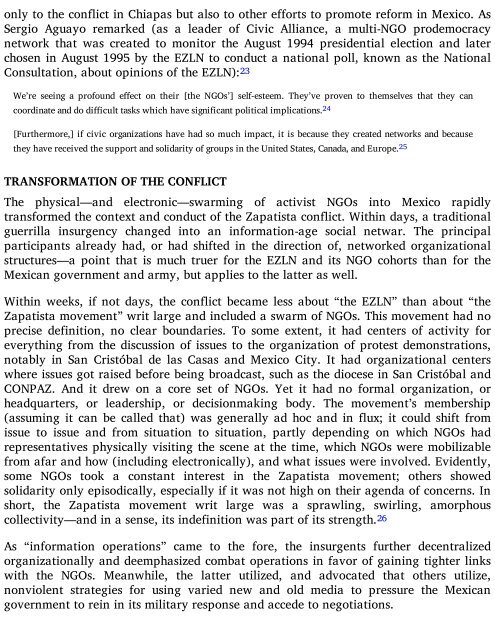RAND_MR1382
You also want an ePaper? Increase the reach of your titles
YUMPU automatically turns print PDFs into web optimized ePapers that Google loves.
only to the conflict in Chiapas but also to other efforts to promote reform in Mexico. As<br />
Sergio Aguayo remarked (as a leader of Civic Alliance, a multi-NGO prodemocracy<br />
network that was created to monitor the August 1994 presidential election and later<br />
chosen in August 1995 by the EZLN to conduct a national poll, known as the National<br />
Consultation, about opinions of the EZLN): 23<br />
We’re seeing a profound effect on their [the NGOs’] self-esteem. They’ve proven to themselves that they can<br />
coordinate and do difficult tasks which have significant political implications. 24<br />
[Furthermore,] if civic organizations have had so much impact, it is because they created networks and because<br />
they have received the support and solidarity of groups in the United States, Canada, and Europe. 25<br />
TRANSFORMATION OF THE CONFLICT<br />
The physical—and electronic—swarming of activist NGOs into Mexico rapidly<br />
transformed the context and conduct of the Zapatista conflict. Within days, a traditional<br />
guerrilla insurgency changed into an information-age social netwar. The principal<br />
participants already had, or had shifted in the direction of, networked organizational<br />
structures—a point that is much truer for the EZLN and its NGO cohorts than for the<br />
Mexican government and army, but applies to the latter as well.<br />
Within weeks, if not days, the conflict became less about “the EZLN” than about “the<br />
Zapatista movement” writ large and included a swarm of NGOs. This movement had no<br />
precise definition, no clear boundaries. To some extent, it had centers of activity for<br />
everything from the discussion of issues to the organization of protest demonstrations,<br />
notably in San Cristóbal de las Casas and Mexico City. It had organizational centers<br />
where issues got raised before being broadcast, such as the diocese in San Cristóbal and<br />
CONPAZ. And it drew on a core set of NGOs. Yet it had no formal organization, or<br />
headquarters, or leadership, or decisionmaking body. The movement’s membership<br />
(assuming it can be called that) was generally ad hoc and in flux; it could shift from<br />
issue to issue and from situation to situation, partly depending on which NGOs had<br />
representatives physically visiting the scene at the time, which NGOs were mobilizable<br />
from afar and how (including electronically), and what issues were involved. Evidently,<br />
some NGOs took a constant interest in the Zapatista movement; others showed<br />
solidarity only episodically, especially if it was not high on their agenda of concerns. In<br />
short, the Zapatista movement writ large was a sprawling, swirling, amorphous<br />
collectivity—and in a sense, its indefinition was part of its strength. 26<br />
As “information operations” came to the fore, the insurgents further decentralized<br />
organizationally and deemphasized combat operations in favor of gaining tighter links<br />
with the NGOs. Meanwhile, the latter utilized, and advocated that others utilize,<br />
nonviolent strategies for using varied new and old media to pressure the Mexican<br />
government to rein in its military response and accede to negotiations.










![Genki - An Integrated Course in Elementary Japanese II [Second Edition] (2011), WITH PDF BOOKMARKS!](https://img.yumpu.com/58322134/1/180x260/genki-an-integrated-course-in-elementary-japanese-ii-second-edition-2011-with-pdf-bookmarks.jpg?quality=85)
![Genki - An Integrated Course in Elementary Japanese I [Second Edition] (2011), WITH PDF BOOKMARKS!](https://img.yumpu.com/58322120/1/182x260/genki-an-integrated-course-in-elementary-japanese-i-second-edition-2011-with-pdf-bookmarks.jpg?quality=85)





